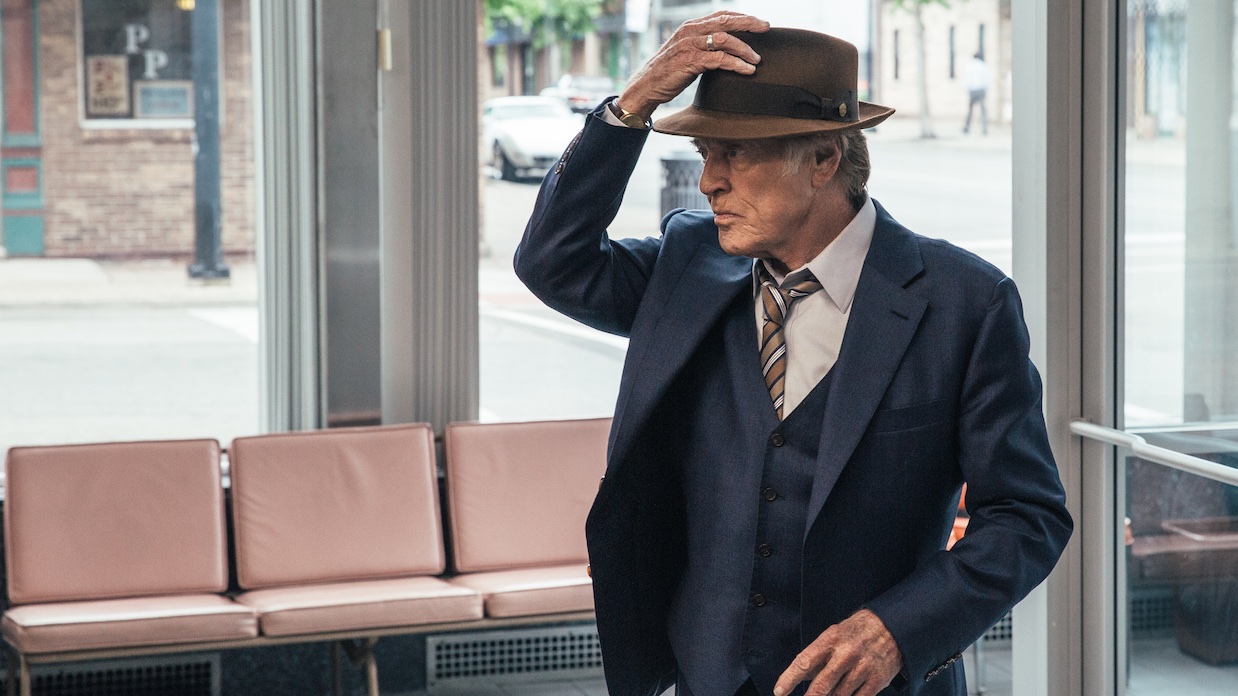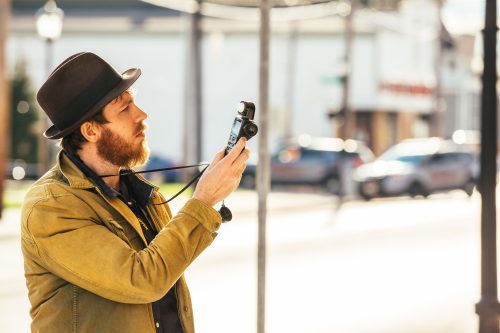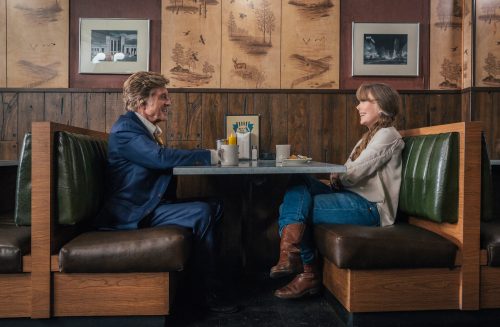 Back to selection
Back to selection
Shutter Angles
Conversations with DPs, directors and below-the-line crew by Matt Mulcahey
The Thrill of the Chase: Cinematographer Joe Anderson on Capturing Robert Redford’s Ride into the Sunset in The Old Man & the Gun
 Robert Redford in The Old Man and the Gun (Photo by Eric Zachanowich. © 2018 Twentieth Century Fox Film Corporation All Rights Reserved)
Robert Redford in The Old Man and the Gun (Photo by Eric Zachanowich. © 2018 Twentieth Century Fox Film Corporation All Rights Reserved) Robert Redford’s final day on David Lowery’s The Old Man and the Gun — perhaps his final day as an actor on any movie set — found him in Texas. Though the amiable based-in-fact caper was shot largely in Ohio on 16mm, Redford’s dapper bank robber actually did most of his pillaging in Texas and its neighboring states. Thus a few pick-ups were needed — the last of which featured Redford’s Forrest Tucker phoning a widowed rancher he’s romancing.
“There was a little bit of electricity in the air for that scene,” said cinematographer Joe Anderson. “The shot worked really elegantly as just one slow dolly-in and after it was over the loader came up to me and one of the producers with the roll of film and said, ‘This is probably the last roll of film that will ever record Robert Redford’s image. So take care of it.’”
With The Old Man and the Gun out in theaters, Anderson talked to Filmmaker about the responsibility (and the pleasure) of shooting what may well be Redford’s ride into the sunset.
Filmmaker: Let’s start with director David Lowery’s script for The Old Man and the Gun. When I interviewed A Ghost Story cinematographer Andrew Droz Palermo, he told me Lowery specified things like aspect ratio and even shot length at the script stage. Were those types of atypical details in his Old Man and the Gun script?
Anderson: One of the big things that David had in the script were all these zoom shots. So even before we had locations or had even decided on a camera format, there were quite a few zooms already at the script level. The montages were also pretty clearly mapped out in the script.
Filmmaker: Was the song “Blues Run the Game” in the script?
Anderson: It absolutely was. “Blues Run the Game” was in the script from Day 1. People were working on the clearance for that song even in preproduction. It plays during the final police chase and that scene has this kind of meta aspect to it. It’s the end of Forrest’s career, and it’s the end of Redford’s career. Redford gets back on a horse one more time and kind of walks off into the sunset, so to speak. That song encapsulated all of those things.
Filmmaker: If this ends up being Redford’s final performance, it feels like such a fitting way to go out. Do you have a favorite Redford movie? We can take The Old Man the the Gun out of consideration.
Anderson: Well, that is my favorite Robert Redford movie. (laughs) I love Conrad Hall so I’d say that Butch Cassidy and the Sundance Kid is probably my favorite. But I’m also a big fan of Sneakers. Sneakers actually played a big role in the color grade. We played with a little bit of a 1990s video tape transfer look for the movie, where it wasn’t super saturated and had slightly lower contrast.
Filmmaker: I read an interview with Lowery where he talked about his early attempts at the script being more journalistic versions of Forrest Tucker’s story. Then he found himself gravitating to a more fanciful version of the events — sort of the version Tucker might have imagined in his own head. How did that idea affect the way you shot the movie?
Anderson: One of the most special aspects of movies as an art form is their ability to demonstrate point of view. Movies can really put you into the world of a character and let you see the world through his or her eyes. And Forrest saw the world as a little bit of an adventure, and that perspective lent itself to the way we shot the movie. One of our goals was to really make the cinematography fun. We wanted the camera to be light, nimble and spontaneous. Redford’s character, Forrest, isn’t very introspective so a lot of the creative decisions weren’t really about dissecting his character. It was more about the thrill of the chase.
Filmmaker: The robbery scenes are definitely light and fun. That’s the opposite of what we’re accustomed to, which is heist scenes played for tension.
Anderson: David has this amazing way he plays with the audience’s expectations. I think people do expect some drama from a bank robbery scene, but David found the bits that happened before and after the robbery to be more interesting.
Filmmaker: The robbery with the most drama — where everything goes wrong — I don’t even think we see any part of that on screen, right? We only see the aftermath.
Anderson: (laughs) Correct. We see the aftermath through police interviews and surveillance footage of it. Instead, we spent a lot of time on the details of casing the bank before the robbery. That was always way more interesting than just some guys showing up with weapons demanding money.
Filmmaker: In the credits I saw the name J. Todd Anderson, who’s known for storyboarding the Coen brothers movies. How did you use those storyboards to help you visualize the movie?
Anderson: J. Todd was a great collaborator. David first worked with a storyboard artist on Pete’s Dragon and found it quite helpful in planning out some of the more elaborate scenes, just another tool to show the crew so everyone can be on the same page. On Old Man and the Gun we worked with J. Todd to do some of the more complicated scenes like the car chases and bank robberies. And we loved J. Todd so much that we actually put him in the movie as a police officer after the failed banked robbery.
Filmmaker: When I interviewed Pete’s Dragon cinematographer Bojan Bazelli he said that for exteriors he didn’t even bother taking lights off the truck — everything was either bounced or diffused natural light. Did you have a similar philosophy of minimalism on Old Man and the Gun?
Anderson: When making a period piece, I think to really do it well and transport the audience back in time you have to acknowledge the way movies were made in the period that the story is set in. Instead of trying to do that with funky old lenses, we used a slower film stock (Kodak 7213 200T) that required a lot more light and then we underexposed it a little bit to give it some more grain. (Shooting at a slower ASA) informed many of the lighting decisions. It’s a very different approach than everybody’s used to nowadays with super fast digital cameras and super light sensitive lenses. We certainly had to balance those lighting needs with the fairly modest budget of the movie, but for some of the night exterior scenes we used 180,000 watts of light just because the film needed it.

Filmmaker: Because you were under-exposing, did you have to bring up the levels by push processing or did you raise them in the Digital Intermediate?
Anderson: I don’t like to push process because that ultimately increases contrast. Instead we underexposed the negative and then in the DI we had to amplify it a bit. That approach, in combination with the fact that we used only one film stock for daylight and tungsten light sources, gave us a consistency throughout the whole movie and it also gave us the perfect amount of grain that we wanted.
Filmmaker: You mentioned being aware of the tools used in the era that a period film is set. Since The Old Man and the Gun is set mainly in the early 1980s, did you lean less on LED lighting since it wouldn’t have been available in that period?
Anderson: We did a little bit. While I think it’s good to give yourself creative boundaries because sometimes that creates very inventive ideas, I also want to be able to use the best tools possible. So for a fair amount of the driving stuff we used LED lights, which give you a quality that (filmmakers) would’ve loved to have used in 1981. But at the same time we did use a lot more tungsten light than people normally use nowadays, when it’s mostly LEDs or daylight (temperature) sources. I worked on (David Lowery’s) Ain’t Them Bodies Saints that Bradford Young shot and Bradford talked about how Tungsten light vibrates in a way that other solid state lights don’t. There’s something about a light that vibrates in order to send out light that’s kind of beautiful.
Filmmaker: You used Cooke S4s as your main lenses, which are from the late 1990s. So you sort of split the difference in terms of era between new lenses and something from the early ’80s.
Anderson: I initially considered limiting myself to the tools of the time that the movie was set in, but ultimately I felt there was a better way to tell the story than just deciding on a manufacturing date. So we essentially just tested and tested and found a look that felt right. We found that using modern, super sharp lenses almost fought against the softness of Super 16. Conversely, shooting with vintage lenses has some downsides in that they are constantly drawing attention to themselves in ways that are hard to control. I want to be able to control when someone notices a lens flare versus having a lens flare forced on me in every shot the way some older lenses do.
We ultimately landed on some early 2000s Cooke S4s as our main prime lenses, but we did also use much more period-accurate zoom lenses. Those really had a great quality and weird aberrations that were fun and matched the look of movies shot in the early ’80s. I also actually went out of my way to track down some period-accurate video equipment because there’s a fair amount of news broadcasts that we shot for the movie. Producers wanted to shoot on a Red and then degrade the image, and I was very insistent on finding ’80s-era video cameras. We ended up finding one at a local cable access TV channel just outside Cincinnati, and that was a lot of fun to use.
Filmmaker: One of my favorite scenes in the film is this digression where Tom Waits’s character, who’s part of Forrest’s “gang,” tells a childhood story involving his step-dad and a Christmas tree. That’s a real story from Waits’s life?
Anderson: When Tom first met David he told him he had this story, and he wondered if there was a place in the movie where he could tell it. So we basically just built a standalone scene for Tom to tell that story. We set up multiple camera angles for it, but ultimately it worked best just as a oner.

Filmmaker: Tell me about the first diner scene where Forrest and Jewel (played by Sissy Spacek) get to know each other. I understand that the B camera didn’t always play a lot on the movie, but I’m assuming you had it rolling here.
Anderson: David and I definitely prefer to shoot with one camera so we try to do that as often as we can. That said, we had the luxury of having a B camera the entire run of the shootm and that was super helpful in terms of getting extra coverage or being able to get close-ups and cutaways after we’d finished a scene with the actors.
For that diner scene, David really wanted to make a special dialogue scene that happens right at the beginning of the movie and takes the audience by surprise. You kind of think you’re just going to breeze through this scene and then move on with the plot, but we end up sitting with these characters and really watching their relationship develop. We learn so much about them. I believe it was a seven or eight page dialogue scene and David, having worked with Redford previously [on Pete’s Dragon], knew how long it would take to shoot a scene like that, and he made sure we had two-and-a-half days to shoot it. It was a challenge for me to keep the lighting consistent as we shot and also to give the actors some breathing room so David could jump in there and give little nuanced notes. That precipitated using two cameras quite a bit for that scene so that we could capture the spontaneity of this flirtatious back-and-forth between Forrest (Redford) and Jewel (Spacek).
Filmmaker: There are these two moments — one during a later diner scene and another on Spacek’s porch — where the camera pans off the actors mid-dialogue and just sort of drifts around the room without any particular purpose. It’s an interesting idea — the camera not being chained to the action.
Anderson: It comes from this idea of letting the camera be curious and not always necessarily having to sit on the close-up of an actor as they say the dialogue.
Filmmaker: I’m from Cincinnati, where much of The Old Man and the Gun was shot, and I know some of the crew people who worked on the movie. I was asking around for stories from the shoot and the B-camera 1st AC, Amy Faust, told me her favorite memory was Tom Waits walking a bunch of the crew down to Dairy Queen for an ice cream. It reminded me that sometimes these interviews get lost in the technical weeds. So I thought I’d finish up by asking if you had any favorite moments from the shoot that have nothing to do with the technical aspects of your job.
Anderson: Just getting to work with Robert Redford. I grew up in Salt Lake City. I’ve been going to the Sundance Film Festival since I was a teenager. I visited the Sundance Institute as a kid and got to see the director’s lab behind the scenes. So just working with Redford was an incredible honor.
Matt Mulcahey works as a DIT in the Midwest. He also writes about film on his blog Deep Fried Movies.
Recommended Viewing
Below you’ll find a list of films that director David Lowery asked cinematographer Joe Anderson to check out before shooting The Old Man and the Gun.
“We watched a lot of reference material, but ultimately we were never trying too hard to replicate anything,” said Anderson. “We didn’t want to, say, copy a specific zoom from a certain movie. Watching those movies was just to get ourselves creatively in the right mindset.”
Bob le Flambeur (1956)
Lonely are the Brave (1962)
Le Samourai (1967)
Downhill Racer (1969)
Two-Lane Blacktop (1971)
Pat Garrett and Billy the Kid (1973)
Straight Time (1978)
Wise Blood (1979)
Thief (1981)
Fantastic Mr. Fox (2009)
